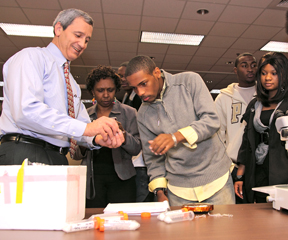Marzell McAfee and Brandon Brown were excited to learn that their Huffman High School biology class would be conducting a science experiment at UAB during their junior and senior years.
 |
| Larry DeLucas shows Huffman High senior Marzell McAfee and his classmates some of the crystals that flew to space on a Russian-owned rocket flown by private astronaut Richard Garriott. Students from Huffman and Indian Springs schools participated in the experiment to grow crystals in space. |
“When they told us the experiment was going to outer space,” says McAfee, “everyone was like, ‘Outer space? Are you kidding?’ That was the coolest thing.”
“And to be able to work with a real astronaut, one who’s been to outer space, was a once-in-a-lifetime opportunity,” added Brown. “Not many other people my age can say they had the opportunity to do that.”
Generating excitement for science was a primary goal of a project conducted partially out of the Center for Biophysical Sciences and Engineering (CBSE) under the direction of Larry DeLucas, O.D., Ph.D., CBSE director and former astronaut. University of Alabama at Huntsville researcher Joe Ng asked DeLucas to be a part of a grant he was awarded from NASA to conduct a protein-crystallization experiment. Ng had students and teachers from five schools in Huntsville participate, and DeLucas asked the students and teachers of Huffman High and Indian Springs schools to be a part of the project.
DeLucas lectured to the students at UAH, and Ng came to UAB to return the favor this past spring. The students learned about crystallization and crystallography, their importance in drug discovery and the ways molecules work in the human body.
The students learned to grow crystals in their own school laboratories and then came to UAB to prepare the actual flight experiment.
“It took about one hour to teach them how to carefully prepare these samples,” DeLucas says. “There are some unique aspects to the hardware. You have to melt the tubing that contains the crystals, and you have to double-seal it on two ends. We had to use a special NASA and Russian-approved sealing device. That was probably the trickiest part, but it didn’t take very long for them to learn how to do that.
“Once they did, I pretty much stood back and watched them do it.”
The crystals were launched into space aboard a Russian Soyuz rocket along with private astronaut and famed video-game developer Richard Garriott, who spent 11 days in space, visiting the International Space Station. The students returned to UAB earlier this month to see the results of their experiment, and they were surprised by the results.
“Seeing how different the data was from Earth to outer space was pretty remarkable,” McAfee says. “The crystals grew much slower but better in outer space than the ones we grew here in the lab. Generally, the slower a crystal grows the better it will be.”
Michal Robinson, a biology teacher at Huffman, says the students were excited about growing the crystals in their school lab after learning the techniques earlier this year.“It was a great experience for the students to try to grow them and see what kind of growth patterns there were and how the whole process worked,” Robinson says. “It was independent work in addition to what we were doing in our class. They would come in during the day and pull out the microscope every week or so and see what was happening. They’ve learned what it’s like to do research and learned that it’s very tedious. But it was such a valuable experience.”
Experiment to be published
NASA was interested in the experiment to see whether the protein found in tiny organisms called extremophiles would crystallize under microgravity conditions. Extremophiles can thrive in extreme hot and cold temperatures and are found in places like Antarctica and near volcanoes.
Crystallization is essential for protein engineering and drug design. The experiment that the students worked on could lead to a greater understanding of the atomic details of the three-dimensional structures for the extremophilic proteins, which could have commercial value in drug development.
The experiment is the first attempt to crystallize some of the extremophilic proteins under microgravity conditions. Ng and DeLucas intend to send the results to an educational journal for publication.
“We’re going to publish the fact this was an experiment designed for education, and the results were really fascinating,” DeLucas says. “We had 150 students involved. I don’t know if we can have that many co-authors, but if that’s not possible they’re certainly going to be in the acknowledgments, all their names and the participating high schools.
I know the students learned a great deal, and I hope this gets them excited about science, technology and engineering.”